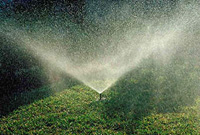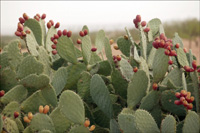 |
||
Ron’s ArticlesWhat You Can DoMay 2007
Let’s apply these principles to our landscapes. As a paramedic I have firsthand knowledge of the dangers of landscape chemicals. I’ve seen people die while spraying their yards. It’s happened so often that the medical field has a term for it - organophosphate poisoning. When you cross nature, you lose. Organophosphate poisoning has had a lot to with my success as a landscape professional. Without observing its effect on human life, it may not have dawned on me that these chemicals destroy the life in the soil. Synthetic Nitrogen: If the nitrogen = explosives doesn’t ring a bell, recall it was a truckload of fertilizer Timothy McVeigh parked outside the Murrah Federal Building in Oklahoma City. City of Austin, Texas Grow Green Program: Weed and feed products are high on their hit list. www.ci.austin.tx.us/growgreen/ Running a sprinkler during a rainstorm: If your sprinklers are running you wash rainwater off. Rain, freeze and moisture sensors are a good investment if you don’t have the time or inclination to monitor your system. Xeriscaping: Even in a drought we can sustain attractive healthy landscapes if we use adapted plants and manage them properly. In any successful landscape program you must have copious amounts of organic material in the soil. If you constantly bombard your landscape with toxic hazardous waste materials, synthetic fertilizers and weed killers, you destroy the life in your soil. Over the past decade I’ve had great success maintaining landscapes- especially during the drought. I’ve restored over 1,000 properties. We’ve saved hundreds of trees - brought them back to an average annual growth of 10 to 12-inches. Where I’ve had complete control, I’ve gained up to 20-inches of new growth. You, too, can achieve these landscape transformations. First: Apply about ½-inch of compost to all turf. Add 1-inch in all established beds and 3-inches in new beds. This single act will increase your water holding capacity by at least 50%. Compost holds water like a sponge. Next: Get rid of all toxic chemicals such as synthetic fertilizers and weed killers. They destroy the soil biota and pollute our waterways. And they’re bad for your family and pets. Don’t use them up. Take them to the hazardous waste dump. Next: Have an irrigation audit. All irrigation systems are mechanical - destined to fail. When they do, you waste thousands of gallons of water. Improperly maintained systems waste of about 30 percent of your water. Have your system checked by a professional - not just a guy who can glue PVC together, but someone who understands the water needs of your landscaping plants. In the summer most landscapes need an inch of water per week. In the winter that should be adjusted to 1/4-inch. A ½-inch will do the job in the spring and fall. Once in a while we get some rain. So, never leave your sprinkler system on automatic. Next: Mulch. It’s a great investment. Mulch shields plants from summer heat and winter cold and minimizes evaporation. Over time it decomposes into valuable organic material. It attracts earthworms that make soil 7 times more effective retaining moisture and releasing nutrients. Two to four inches of shredded hardwood or cedar is best. Pine bark is the worst. Next: Mow properly. Never scalp your lawn. Mow weekly whether or not it looks like it needs it. It really cuts down on weed propagation. Sharpen your mower blade at least monthly. Just one cut with a dull blade causes incredible damage. By ripping rather than cutting, you expose up to 7 times more surface to transpiration and to pathogen access. Start fairly low in the spring - 1½-inches. Increase gradually to 3 to 4-inches in August - taller for St. Augustine. Finally: Feed your landscape every 8 to 12 weeks. Use well balanced amendments with a wide range of ingredients. Diversifying nutrients is good. It promotes micro-organisms that build organic mater in the soil. If you take these simple steps, your landscape will stand out and your water bills will go down. PS: If they outlawed synthetic fertilizers tomorrow it would be okay with me. They are the prime culprits in water and air pollution. 
|
|
|


|
||

 Chemical companies developed synthetic nitrogen as explosives to help us win World War II. When the war ended, they had stockpiles left. So, they turned them into fertilizer and foisted them on the returning GI’s - many of them first-time homeowners.
Chemical companies developed synthetic nitrogen as explosives to help us win World War II. When the war ended, they had stockpiles left. So, they turned them into fertilizer and foisted them on the returning GI’s - many of them first-time homeowners. The City of Austin is well ahead of the curve. They’re strongly promoting “Grow Green!” - Earth-wise solutions with an emphasis on water quality protection.
The City of Austin is well ahead of the curve. They’re strongly promoting “Grow Green!” - Earth-wise solutions with an emphasis on water quality protection. It aggravates me to see sprinklers running during a rainstorm. It’s not just the waste. Rainwater is much better for your plants. City water is mildly toxic with chlorine and such.
It aggravates me to see sprinklers running during a rainstorm. It’s not just the waste. Rainwater is much better for your plants. City water is mildly toxic with chlorine and such. I’m not into xeriscaping. We don’t live in a desert. Our native landscape was grasslands and trees, not rocks and cactus.
I’m not into xeriscaping. We don’t live in a desert. Our native landscape was grasslands and trees, not rocks and cactus.